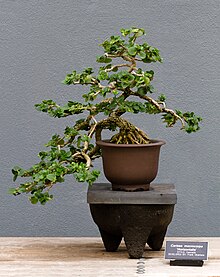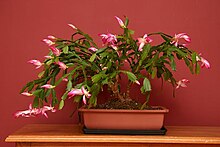 Carissa macrocarpa developed by Frank Okamura
Carissa macrocarpa developed by Frank Okamura Indoor bonsai are bonsai cultivated for the indoor environment. Traditionally, bonsai are temperate climate trees grown outdoors in containers.[1] Tropical and sub-tropical tree species can be cultivated to grow and thrive indoors, with some suited to bonsai aesthetics shaped as traditional outdoor or wild bonsai.[2][3]
Bonsai and related practices, like penjing, hòn non bộ, and saikei, involve the long-term cultivation of small trees and landscapes in containers.[1][2] The term bonsai is generally used in English as an umbrella term for all miniature trees in containers or pots.[2]
Indoor vs. traditional bonsai
Indoor bonsai is the cultivation of an attractive, healthy plant in the artificial environment of indoors rather than using an outdoor climate, as may occur in traditional bonsai.[2] Indoor penjing is the cultivation of miniature landscapes in a pot or tray, possibly with rocks, bonsai trees, and ground covers, and sometimes with small objects or figurines.[2]
Bonsai vs. other forms of house plant
Compared to the usual potted house plant, bonsai are rooted in a much smaller amount of soil. Consequently, they require more frequent watering and feeding.[4] This form is therefore best suited for drought-resistant species. Compared to usual house gardening, bonsais require a lot more pruning, both of branches and roots. This often requires a significant shift in attitude for home gardeners.[citation needed]
The spiritual benefits of bonsai cultivation (bonsai no kokoro[5]) are available equally to classical and indoor bonsai gardeners.
Cultivation and care
Many of the techniques used to grow and shape outdoor bonsai apply equally to indoor bonsai. For example, shaping techniques like pruning, wiring, and grafting work much the same for both types of bonsai. But indoor bonsai also have some special requirements for cultivation and care.[citation needed]
 Christmas Cactus (Schlumbergera)
Christmas Cactus (Schlumbergera) Lighting
An indoor room comfortably lit for human use provides too little light for most species of tree to grow.[6] Few species will thrive with less than 500 lux available several hours per day. Successful indoor bonsai cultivation requires either selecting from the short list of low-light-tolerant trees, or providing additional lighting for the trees. Insufficient light may not kill some species outright, but will make their growth so slow that the bonsai shaping techniques cannot be used: the plant will not grow back after pruning or leaf trimming.[7]
The simplest way to provide extra light is to place the bonsai close to an outside window. Care is taken not to harm the plant either with cold air entering through the window, or with high radiated heat from direct exposure to the sun. More controllable light, and more flexibility in situating the bonsai, can be obtained using artificial lighting. Fluorescent lighting (preferably with bulbs radiating growth-friendly spectra) and light-emitting diode lighting can give sufficient light to support a significant number of indoor bonsai species. These lights also have the advantage of blending with other indoor lighting, so that the plants can be grown in normal living quarters. For plants needing the highest amount of light, or for large numbers of bonsai being maintained indoors, a space dedicated to bonsai cultivation can support high-intensity lamps and optionally the special ventilation or cooling often needed for their use.[7]
You received this message because you are subscribed to the Google Groups "1top-oldtattoo-1" group.
To unsubscribe from this group and stop receiving emails from it, send an email to 1top-oldtattoo-1+unsubscribe@googlegroups.com.
To view this discussion on the web visit https://groups.google.com/d/msgid/1top-oldtattoo-1/CAGNPKmkb%2B5O885zhij8a5ogZDESq8%3D-r7abJOiAOJX4YO5jz3g%40mail.gmail.com.
No comments:
Post a Comment